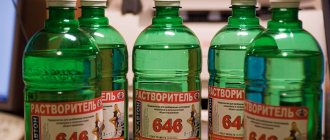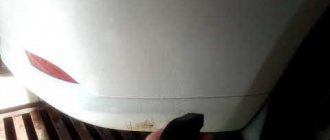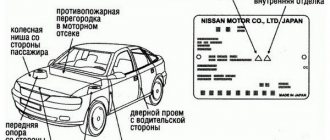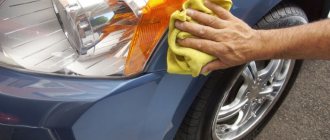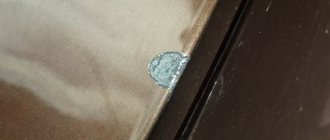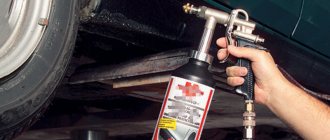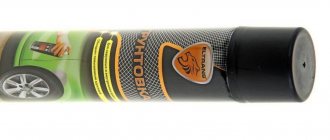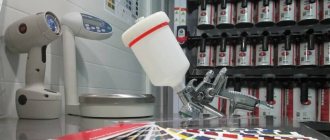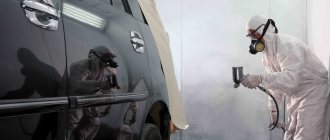Why thin the paint?
When the preparatory work on the body is completed, microcracks still remain on the surface, invisible to the eye. It is necessary to dilute the paint so that it can fill all cracks and microcavities. The dilution process allows you to reduce the viscosity of the composition and density. Due to dilution, the dye better adheres to the surface in a thin and uniform layer.
Also, the specifics of the work depend on the physical properties of a particular coloring composition. If a spray gun will be used as the main working tool, then the paint for painting the car must be diluted to a liquid state. This will allow the coloring material to pass through the spray nozzle better. When working with a brush, the viscosity of the paint should be lower.
Also, the composition must dry quickly so that smudges and other defects do not appear on the body. To minimize the cost of purchasing the necessary materials and at the same time not lose the quality of the painting, you need to know how to properly dilute the paint, depending on its composition.
Transparent layer before applying metallic
One of the problems that arises with paints that have a high content of metal particles (for example, metallic silver) is that metal flakes can collect in even small scratches of the surface being painted. This may affect the final result. Sometimes, before varnishing, the transition looks good. After varnishing, metallic particles may settle into small scratches, and this will be noticeable.
p, blockquote 6,0,0,0,0 —>
To combat such drawdown, as well as halos and a visible transition line, you can use a transparent base (binder). This can be either a diluted binder (in fluidity as a base) or a very thinly diluted varnish. This coat will fill in minor scratches and will give the metallic a smoother surface to apply. In addition, it turns out something like a wet substrate, when applied to which the metallic particles fit as they should. Manufacturers in English call this layer “orientation coat”, as it helps to correctly distribute the metallic particles (orient). This layer can be used both when painting with a smooth transition, and when simply painting the panel.
p, blockquote 7,0,0,1,0 —>
An orientation coat is sprayed onto the entire panel to be painted before the paint is applied. A full wet coat must be applied. Despite the use of an orientation layer, surface preparation must still be thorough. This layer is optional and can be used at the discretion of the painter.
p, blockquote 8,0,0,0,0 —>
Composition of car paints
All automotive paints and enamels contain three basic components:
- pigment is a powder substance that gives paint the required color;
- binder base - it holds the pigment and ensures adhesion of the material to the surface;
- solvent - with its help the composition is given the necessary consistency.
Different types of dyes have different physical characteristics - elasticity, density, degree of fullness, and hardness of the layer after drying.
Requirements for automotive solvent
The main condition when determining which solvent can be used to dilute car body paint will be the absence of chemical reactions with its other components. The substance used as a solvent must have the following properties:
- full compatibility with the base varnish in terms of basic consumer characteristics - the level of gloss of the coating, its optical properties, transparency;
- the material itself must be colorless and not change the shade of paint when added;
- do not exhibit a coagulant effect, that is, do not lead to the separation of paintwork materials into components, the formation of solid sediment or the appearance of interphase boundaries;
- evaporate completely without leaving marks on the coating.
In addition to the technological requirements listed above, sanitary, environmental and fire safety requirements are very important. Vapors from most volatile organic substances are toxic to humans, so for household work it is better to use a solvent with the highest MPC in the air.
Types of solvents
Any automotive enamel is sold in liquid form, but this does not mean that it can be used immediately. The manufacturer has already added a solvent to the paint, but just enough so that the composition does not dry out. To obtain an even coating, the material should be diluted additionally. This coating will protect the body from damage and corrosion.
Before mixing paint with solvent, you need to remember that the manufacturer has already added a certain amount. Depending on this, coloring compositions are divided into:
- highly filled;
- medium filled;
- low-filled.
Fullness is a property that determines the volatility and viscosity of the enamel; it helps to understand how much more solvent can be added.
By evaporation rate
Solvents, just like paints, come in different forms; let’s look at their main types. Depending on the evaporation rate, the following compositions are distinguished:
- Slow - they are used for work in the summer or at high temperatures.
- Fast - the components in the composition speed up the drying process and make it possible to work with the material even in winter.
- Universal - allowed for use at average temperature conditions.
According to physical and chemical indicators
Depending on the physical and chemical characteristics, two groups of solvents are distinguished:
- Polar - alcohol, ketones, substances with hydroxyl group molecules. These materials are suitable for working with acrylic paints.
- Non-polar - white spirit, kerosene, a complex of hydrocarbon-based compounds.
In order to accurately determine how to dilute a particular paint, you should find out what solvent the manufacturer used. Match polar to polar or non-polar to non-polar.
Measuring viscosity
Any painter should be able to control such a vital indicator as viscosity. For what? So that it corresponds to the recommended size. Again, why? To evenly apply the material to the surface and obtain a coating of the required thickness with the required properties - beautiful and durable.
“Viscosity” (from Latin viscosus - sticky, sticky) is a value characterizing the fluidity of a liquid.
Why measure viscosity?
For more details, use the example of filler soil. The surface on which we apply it has various kinds of micro-irregularities left after preparation (grinding marks, pores, etc.). In other words, protrusions and recesses. From the deepest to the highest point - approximately 50 microns.
So, if we apply too liquid a filler to this surface, its thin film will not be able to cover these irregularities, and even with a margin for grinding (by analogy: if you put pebbles on the bottom of a jar and pour water without covering the stones “overall” ). As a result, the surface will remain uneven, and the soil, by and large, will be wasted. You have to do extra work - reapply the filler, spending twice as much time on repairs.
Let's take the opposite situation with applying too thick filler. It would seem that there certainly shouldn’t be any problems here. No matter how it is. A filler that is too thick and non-flowing, again, will not be able to properly fill all the micro-irregularities - its penetrating ability is too low and it is simply not able to flow into these small depressions (just as a soccer ball cannot fall into a golf hole).
The coating turns out to be loose, poorly adhered to the surface, and subsequently the filler begins to peel off. Not a very rosy prospect, but the troubles don’t end there. A filler that is too thick will not be able to spread over the surface in a smooth layer; increased shagreen is formed, which leads to torment and excessive consumption of materials during sanding.
And this is just a filler primer! What can we say about paints and varnishes? Gloss, shade, texture and adhesion again... All this directly depends on viscosity.
Someone will ask: “What if you dilute it thinner so that it flows everywhere, adheres well and spreads smoothly, and apply it thicker so that there is room for sanding?”
Not the best solution, to put it mildly. A thick layer of liquid material contains a large amount of solvent - the coating will remain soft for a very long time (until it dries completely, not hours or days, but weeks and months), and enamel applied over a wet primer can lead to wrinkling of the coating and poor adhesion between the paint and the primer . In addition, the likelihood of such unpleasant defects as “boiling” and many others increases.
So, it is imperative to be able to control viscosity. The question arises: how?
How to measure viscosity?
You can often see how viscosity is measured in the following way: a painter takes some long object (for example a screwdriver), dips it into a can of prepared paint and God knows, by the signs, determines whether the viscosity is optimal or whether it needs to be diluted more.
It is worth saying that if this method is good, it is only for professionals with very extensive work experience. Well, someone, and they, as they say, feel the paint and varnish material with their skin. But what should novice painters who don’t have much experience do?
From our school physics course, we know that viscosity is usually measured in pascal seconds (dynamic viscosity) or in square meters per second (kinematic viscosity). It is also known that methods for determining the true viscosity properties of liquids are quite complex, which means they are not suitable for use in repair shops. Therefore, such a concept as “conditional viscosity” was introduced into circulation.
Determining conditional viscosity comes down to measuring the time (in seconds) when a certain volume of liquid (100 ml) flows from a funnel through a hole of a certain diameter (usually 4 mm).
So don’t be surprised when you see the inscription on a can of paint: “working viscosity 22-24 s.” This only means that the material needs to be diluted to a conditional viscosity of 22-24 s, which is determined using a special device - a viscometer, which is a cylindrical measuring container with a volume of 100 cm³ with a conical lower part and a hole in it.
The most common viscometer for measuring the viscosity of paintwork materials is the DIN4 standard - with a hole diameter of 4 mm. In our standard it is called VZ-4. The VZ-246 funnel can also be used, only it has replaceable nozzles - with diameters of 2, 4 and 6 mm.
Viscometer DIN4. Our standard is VZ-4
Foreign paint manufacturers may recommend other devices to measure the viscosity of their materials, for example, a Ford #4 viscometer (nozzle diameter 1/6 inch or approximately 4.2 mm), some companies may also recommend their own viscometers.
In practice, any of them can be used with equal success: all of these devices are designed according to the same principle, and there are special nomograms and graphs for recalculating readings. This will not affect the measurement accuracy; the error is leveled by the permissible spread of the working viscosity.
How to use a viscometer? An approximate diagram is as follows. We fix the viscometer vertically, place a clean container with a volume of more than 100 ml under it, close the drain hole of the viscometer and pour paintwork into it flush with the edges. Let the material sit a little so that all air bubbles come out of it. The resulting foam can be removed with a knife or glass rod.
Then we open the drain hole and at the same time turn on the stopwatch. We complete the measurement when the liquid stops flowing in a continuous stream and begins to drip. The time recorded on the stopwatch in seconds is the conditional viscosity of the liquid. For example, the viscosity of water at 20 °C according to DIN4 is 13 seconds.
Viscosity is the most important indicator. It determines the material consumption, the optimal mode of its application, as well as the properties of the resulting coating.
I will add that measurements should be carried out at a temperature of 20±0.5°C. Deviations from this temperature are fraught with inaccurate measurements, since when the temperature rises, the viscosity of the material decreases, it becomes more fluid, and when it decreases, on the contrary, it increases.
The average working viscosity at 20 ºC according to DIN4 is:
- for acrylic enamels - 18-20 seconds;
- base enamels - 16-17 seconds;
- varnishes - 18-20 seconds;
- 2K soils - 20-22 seconds;
- liquid putties - up to 30 seconds.
For exact recommendations, see the instructions for this or that paintwork. Let's say the specified viscosity is 22 seconds. If the paint takes longer to flow out, then its viscosity is higher than normal and it needs to be diluted a little more.
By the way, the thinners themselves are “slow” and “fast” - depending on the evaporation rate and the temperature conditions under which they must be used. Thus, at low temperatures it is worth using “faster” thinners, and when working in hot weather, “slow” ones. In standard temperature conditions (18-25°C), respectively, standard. Read more about this here.
How to dilute paint correctly
The manufacturer indicates on the packaging how much solvent needs to be added to achieve the desired consistency. For example, in the case of using acrylic, which already contains a certain proportion of activator, solvents are added in a minimal volume - the proportion is 10-15% of the total amount of paint.
How to dilute paint if it is a two-component composition? Many people use the following proportions: for 1 liter of paint they use 0.5 liters of solvent and 150 ml of hardener. How correctly the proportion is observed, the quality of the result will be.
To ensure that the paint is prepared correctly, experts recommend using a measuring ruler or flask. This is necessary to ensure that the proportions of the coloring composition, hardener and solvent fully correspond to those recommended by the manufacturer.
You should also obtain the correct viscosity of the diluted mixture - this is determined using a viscometer. You can determine the viscosity by eye - the liquid should drip and not flow in a stream.
Viscosity also varies depending on how and with what the coloring is done. So, for spray guns with a small nozzle, it is necessary that the coloring composition be liquid, but for working with a brush or roller, you can make the dye thicker.
Experts recommend that mixing containers have a strictly cylindrical shape. This is the only way to mix all the ingredients evenly and measure the quantities correctly. The best measuring container is a plastic jar with a lid. There are markings on it that allow you to mix components in different proportions. The base is poured into the container to the required division, and then a hardener or solvent is added there. Using a measuring ruler, the components are conveniently mixed - the paint is diluted.
Often a measuring ruler is sold along with the paint, and on cans of famous brands there are always proportions according to these rulers.
In the video: how to simply dilute paint.
50% hardeners and up to 20% solvent are added to the two-component composition. The degree of dilution of the base enamel can range from 50% to 80%. It’s best to look at the instructions for exactly how to dilute the paint.
Features of automotive enamels
The industry produces several dozen types of paints, differing in the chemical composition of the base component, which determines its properties and the scope of application of the film-forming base. On store shelves you can see hundreds of varieties of paints: water-dispersion, latex, acrylic, pentaphthalic and glyphthalic, nitrocellulose, epoxy, polyurethane, silicone, bitumen and many others. However, the special requirements for paintwork materials for car body painting are such that a very limited range of materials is suitable for this work. Accordingly, the possibility of using solvents for them will be limited.
Melamine-alkyd (ML). These enamels are classified as conveyor enamels because they require high temperatures to cure. Paints based on ML resins dry using a polymerization rather than a condensation mechanism, that is, a chemical reaction occurs during the drying process. This requires heating the part to be painted to 105...120 °C, which is achieved in the factory using special drying chambers. The result is a highly durable film that is resistant to mechanical damage and has a perfect gloss. To be able to apply ML enamels at home, special additives are used - drying accelerators that initiate forced polymerization. However, you need to know that in this case, the indicators of adhesion (adhesion strength to the base), as well as resistance to bending on thin body parts will be significantly worse than the factory ones.
Alkyd (PF or GF). They are based on the same resins that make up the usual building paints. Drying requirements are also more democratic. Most alkyd enamels can be dried even at room temperature +20 °C by condensation, that is, due to the evaporation of volatile solvent vapors. Therefore, such materials are used as car repair materials for touching up individual parts or small areas of the body. They are often packaged in aerosol cans for self-application without the use of compressed air. However, ease of operation results in a number of disadvantages, including significantly lower resistance to moisture and corrosion, vulnerability to mechanical damage, and low gloss level. Even the visually tinted body elements with alkyds differ from the neighboring ones, which have retained the factory paint. You can partially compensate for these disadvantages by applying several thin layers of diluted varnish on top.
Acrylic (AK). A modern type of paint and varnish material that appeared relatively recently with the development of chemistry. Enamels on acrylic resins, like ML, dry by polymerization. Therefore, completely dried acrylic paint cannot be returned to a usable state by adding solvent to it and stirring for as long as desired. At the same time, the drying speed can be quite high, and the gloss and resistance to damage is higher than that of alkyds.
On a note. It is important not to confuse two similar names for substances that are completely different in composition and use. There are water-soluble paints based on an aqueous dispersion of acrylic polymer and car repair acrylics based on an organic solvent. The first type of paint is good for construction; it is used to paint walls and ceilings in houses. The second type is for painting metals, including car body parts. An ignorant person may think that all acrylic paints are the same and will use advice from the Internet on diluting them with water. In this case, the organosoluble material will be hopelessly damaged.
Dilution of metallic paint
Metallic paints differ from traditional ones by the presence of aluminum powder in their composition. These are auto enamels that consist of a binder, pigment, solvent, and small metal particles. The paint should be applied in a thin and even layer - for this it must be liquid. Let's see how to thin metallic paint.
The most commonly used proportion of solvents and coloring compounds is 1:1. But this depends on the method of application of the latter. First of all, the surface is painted with a dry layer - for this you should prepare 2 parts of dye and 1 part of solvent. Then a second thick layer is applied, basically in a ratio of 1 to 1. After drying, another similar layer is applied, but thinner.
To paint a car well, you need to choose the right dye and color. There are many colors to suit every taste, and we already know how to dilute them correctly. Therefore, high-quality results are guaranteed.
Additional recommendations (2 videos)
Various solvents (23 photos)
Single component materials
These include organic and inorganic compounds that exhibit solvating activity in relation to the varnishes and resins that make up the paint. Inorganic (water, acids and salt solutions) are practically never found in car painting. Selected organic substances supplied for dissolving paints:
Acetone. Substance of the group of saturated ketones, chemical formula CH3—CO—CH3. It is a highly active aprotic polar solvent. Needed for working with materials such as nitrocellulose, polyurethane, polycarbonate, epoxy resins. These types of varnishes are practically not used for car enamels, so pure acetone is not suitable for diluting them. However, it can be part of some complex multi-component formulations, and can also be used as a surface degreaser.
Xylene. An aromatic hydrocarbon with the formula (CH3)2C6H4. A colorless liquid with a sharp, specific odor, obtained from coal through the process of dry distillation. Shows high solvent activity in relation to synthetic resins from which paints are produced, including automotive ones. It is rarely used in its pure form, but is found in many compound formulations. The reason for the limitation is the ability to accumulate inside the human body (mainly in the liver), leading to chronic diseases. With a single inhalation of vapors in high concentrations, it affects the psyche, causing excitement or intoxication, therefore it is allowed to work only in well-ventilated spaces with the use of protective equipment.
Toluene. Another common aromatic substance with the formula C6H5-CH3. It is used in large quantities in the paint and varnish industry as a solvent for most resins and varnishes, including the group of auto enamels. You can find toluene in the formulation of the most popular mixed solvents: R-4, 646–649. Use in its pure form is limited by the presence of toxic and weak narcotic properties.
Butyl acetate. A popular organic solvent of the ester group with the chemical formula C6H12O2. It is characterized by low toxicity compared to other organic liquids, and has a pleasant aroma of pear essence. It is active in dissolving many common paints and varnishes: alkyds (glyphthalic and pentaphthalic paints), nitrocellulose and many others. It is used independently and is also included in the recipes of the most famous mixtures (646, 648).
If the paint has dried
Sometimes people are interested in how to dilute car paint, of which there is still a lot in the can, but it is already so thick that the brush stands in it and does not fall off. The rules are basically the same; but since there is nothing left to lose, you can take the simple route and use the 646th solvent
or its analogues. This thinner is considered universal and should help. And if the enamel curls or flakes, the jar is still incomplete.
Another thing is that the very expediency of its use raises doubts: the properties of the enamel after such disturbances have probably changed, and what color it will give after drying is a big question.
In addition, mini clots could have formed in the paint, invisible to the eye, but forming an unattractive shagreen on the body. So this enamel is only suitable for minor touch-ups in inconspicuous places. However, the issue of application, of course, will be decided by the amateur car painter himself.
How much paint do you need to paint a car?
Painting involves a certain amount of materials, the consumption depends on a number of reasons:
- What surface is covered, its dimensions;
- Depending on the brand of paint, the coating spreads differently.
- Sometimes paint needs to be applied several times to achieve the desired color.
- It is important to know what primer was used, its color and quality.
- The spray gun and its more important properties are important when painting the body.
We recommend reading about the spray booth, what it should be like, and the compressor for the spray gun.
Properly diluted paint is not wasted as much, which allows you to save money and achieve high-quality painting.
A viscometer will be no less useful in your work, but if you don’t have one at hand, it’s enough to use a regular ruler.
Only experienced craftsmen can dilute paint with solvent by eye, but for beginners, these instructions are necessary.
Two-component enamel requires the following proportion: 100 ml of hardener plus 500 ml of solvent mixed with a liter of paint.
To avoid confusion with proportions, it is best to use a measuring ruler or even a glass. An equally important task is to achieve the required viscosity.
If you don’t have a device at hand to measure this indicator - a viscometer, then you can use the traditional method: if the paint does not flow, but drips, then everything is normal with viscosity.
The fluidity of the paint is also an important factor when using a spray gun; in this case, for a device with a small diameter nozzle, a liquid composition is required, but if the work is carried out with a roller, then the thickness is important here.
Before you start painting, it is best to test the diluted substance on a coating that you do not mind using.
To make sure that the diluted material is correct, you don’t need a lot of substance, you need to use a brush or device a couple of times.
Do not forget that fluidity directly depends on temperature; it turns out that the warmer it is, the greater the viscosity.
You shouldn’t keep the paint in the container for a long time; it will harden over time, so for proper work you may need to dilute a new proportion of the solution.
Choosing paint for painting a car
Depending on the concentration of components, all enamels are divided into: highly filled, filled to the middle, low filled.
In the first case, such paint is marked with the abbreviation VHS, but low-fill paints are designated as LS.
“Fullness” is a property that is responsible for the viscosity and volatility of a material. Knowing this criterion, you can determine how much solvent and other components are added to the paint so that it does not dry out.
Before applying paint, you should always read the instructions for it.
How much paint will it take to completely decorate a car? This question interests not only beginners in this matter, but also more experienced car enthusiasts who have already encountered this issue.
This issue must be approached individually. The amount of paint used is also affected by the previously selected solvent.
They can be polar and non-polar. To avoid possible compatibility problems, many experts recommend using products from one manufacturer, because this is the only way to avoid all sorts of defects.
Paint made from polar components is mixed with the same solvent, which contains hydroxyl group substances - ketones, alcohols, etc. Non-polar substances include other substances, for example, white spirit, kerosene.
Trying to make a replacement is strictly prohibited. In order to change the viscosity of the consistency, you can use a special device, a viscometer.
Such a device will not be as expensive as you think, but its role is irreplaceable. The holes in this container are calibrated.
When working, you can use viscometers of different volumes and diameters. How many seconds will the material flow out of this device, these are the indicators of its viscosity.
To obtain the most accurate data, all work with the device must be carried out in a certain temperature regime.
To correctly determine the type of composition, you should understand what type of solvent is specified in the instructions for the paint.
For example, if the composition contains acetone, then it comes into contact only with polar compounds. Many people consider xylene and benzene to be universal solvents; they are not so tied to the components of the paint.
Paint and varnish compositions have their own numbers, which allows you not to get confused in the presented options:
- No. 646 is a very aggressive solvent that dilutes the paint and can make real changes to its composition.
- No. 647 is also a very aggressive composition, dilutes nitro enamel and nitro varnish, requires increased safety;
- No. 650 – softer action, used with many paints and varnishes;
- R-4 - for paint containing chlorinated polymers.
What determines the dilution of auto enamel?
The need to dilute auto enamel is dictated by its following properties:
- density;
- viscousness;
To obtain a high-quality composition suitable for application with a spray gun, you must strictly follow the instructions and not conduct experiments
- drying speed;
- viscosity;
- fullness.
The last indicator is the most important. With the same viscosity, coatings have different concentrations of polymers. Large filling is considered the best for a spray gun. This indicator is indicated on the cans with the following markings, in increasing order of fullness:
- LS;
- HD;
- HS;
- MS;
- UHS;
- VHS.
You can safely dilute high-filled VHS enamels, and be very careful not to overdo it with the thinner - low-filled LS, bringing them to the desired consistency.
See also:
Types of paints for cars
Which paintwork to choose for a car?
There are several types of paints that are used for painting a car. Today, four types are most often used:
- acrylic enamels, which have the ability to dry quickly, forming a durable, shiny layer;
To choose the right solvent, you need to know the composition and properties of the paint used.
- alkyd car paints that require long-term drying and form a surface resistant to mechanical or chemical influences;
- nitro enamels, the coating of which has low resistance to external factors; one of the most popular nitro paints is synthetic enamel with a metallization effect (metallic);
- water-based paints, which have been used only recently, but are already gaining popularity due to their environmental friendliness.
Each owner must decide for himself which material to choose for painting a car based on its properties or cost.
See also:
How a passenger wanted to scam a bus driver out of 200,000 rubles
How to thin car paint? Some useful tips
There is an opinion that thinking about how to dilute car paint is an absolutely unnecessary point. They say that it is already fully prepared for further use. Some of the varieties of automotive enamels, however, already contain a certain amount of solvent. However, it is worth remembering that during storage (and the paint did not reach you immediately from the factory), all such materials thicken. It’s not for nothing that they often come with thinners: it’s wiser to dilute the composition right before use, without guessing how much solvent has evaporated since the enamel was packaged in a jar.
However, even if a thinner is not included, the packaging must indicate which one is suitable for this particular paint and its recommended amount. Don’t neglect these instructions: there are many manufacturers, car enamels have different compositions, and if you don’t want to ruin the body of your car or spend money on repainting it, you should read what the manufacturers wrote on the can. How to dilute car paint and how much to pour such liquid also very much depends on the ambient temperature. So before buying a solvent, it is worth assessing all the conditions in which you are going to paint.
